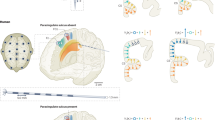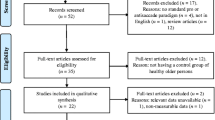Abstract
Conscious monitoring of behavior is an essential control function for adaptation and learning. Antisaccade performance was investigated in a large sample of young healthy men in two tasks, one that required conscious error monitoring and one that did not. Conscious error monitoring did not lead to changes in error rate between the two tasks, while other antisaccade parameters were significantly modulated. Application of signal detection theory showed a large inter-individual variability in error detection sensitivity: the majority of individuals were unable to monitor antisaccade errors (chance error detection group), while a minority that successfully monitored their errors (non-chance error detection group) were worse in antisaccade performance in both tasks. These results were explained by the hypothesis of two modes of antisaccade processing favored by each one of the two groups: a mode of conscious cortical cognitive control leading to error monitoring, worse performance and no post-error adaptation and a mode of non-conscious subcortical control leading to chance error monitoring, post-error slowing and better performance of the antisaccade task. This hypothesis was corroborated by the results of the genotype analysis. Error-monitoring sensitivity in the non-chance error detection group was modulated by COMT genotype variations that in turn did not have an effect on error rate. On the other hand, DRD4 genotype variations were related to differences in antisaccade error rate while not affecting error-monitoring sensitivity.



Similar content being viewed by others
References
Avramopoulos D, Stefanis NC, Hantoumi I, Smyrnis N, Evdokimidis I et al (2002) Higher scores of self reported schizotypy in healthy young males carrying the COMT high activity allele. Mol Psychiatry 7:706–711
Blasi G, Mattay VS, Bertolino A, Elvevag B, Callicott JH et al (2005) Effect of catechol-O-methyltransferase val158met genotype on attentional control. J Neurosci 25:5038–5045
Botvinick MM, Braver TS, Barch DM, Carter CS, Cohen JD (2001) Conflict monitoring and cognitive control. Psychol Rev 108:624–652
Botvinick MM, Cohen JD, Carter CS (2004) Conflict monitoring and anterior cingulate cortex: an update. Trends Cogn Sci 12:539–546
Carter CS, Braver TS, Barch DM, Botvinick MM, Noll D et al (1998) Anterior cingulate cortex, error detection and the online monitoring of performance. Science 280:747–749
Chen J, Lipska BK, Halim N, Ma QD, Matsumoto M et al (2004) Functional analysis of genetic variation in catechol-O-methyltransferase (COMT): effects on mRNA, protein, and enzyme activity in postmortem human brain. Amer J Hum Genet 75:807–821
Egan MF, Goldberg TE, Kolachana BS, Callicott JH, Mazzanti CM et al (2001) Effect of COMT Val108/158 Met genotype on frontal lobe function and risk for schizophrenia. Proc Natl Acad Sci USA 98:6917–6922
Endrass T, Franke C, Kathmann N (2005) Error awareness in a saccade countermanding task. J Psychophysiol 19:275–280
Endrass T, Reuter B, Kathmann N (2007) ERP correlates of conscious error cognition: aware and unaware errors in an antisaccade task. Eur J Neurosci 26:1714–1720
Evdokimidis I, Smyrnis N, Constantinidis TS, Stefanis NC, Avramopoulos D et al (2002) The antisaccade task in a sample of 2,006 young men. I. Normal population characteristics. Exp Brain Res 147:45–52
Everling S, Fischer B (1998) The antisaccade: a review of basic research and clinical studies. Neuropsychologia 36:885–899
Fischer B, Weber H (1992) Characteristics of “anti” saccades in man. Exp Brain Res 89:415–424
Fossella J, Sommer T, Fan J, Wu Y, Swanson JM et al (2002) Assessing the molecular genetics of attention networks. BMC Neurosci 3:14
Hallett PE (1978) Primary and secondary saccades to goals defined by instruction. Exp Brain Res 18:1279–1296
Holroyd CB, Coles MGH (2002) The neural basis of human error processing: reinforcement learning, dopamine and the error-related negativity. Psychol Rev 109:679–699
Klein TA, Endrass T, Kathmann N, Neumann J, von Cramon DY et al (2007) Neural correlates of error awareness. Neuroimage 34:1774–1781
Krämer UM, Cunillera T, Càmara E, Marco-Pallarés J, Cucurell D et al (2007) The impact of catechol-O-methyltransferase and dopamine D4 receptor genotypes on neurophysiological markers of performance monitoring. J Neurosci 27:14190–14198
Macmillan NA, Creelman CD (2005) Detection theory: a user’s guide, 2nd edn. Lawrence Erlbaum Associates, Mahwah
Marco-Pallarés J, Camara E, Münte TF, Rodríguez-Fornells A (2008) Neural mechanisms underlying adaptive actions after slips. J Cogn Neurosci 20:1595–1610
Massen C (2004) Parallel programming of exogenous and endogenous components in the antisaccade task. Q J Exp Psychol A 57:475–498
Miller EK, Cohen JD (2001) An integrative theory of prefrontal cortex function. Annu Rev Neurosci 24:167–202
Mokler A, Fischer B (1999) The recognition and correction of involuntary prosaccades in an antisaccade task. Exp Brain Res 125:511–516
Munoz DP, Everling S (2004) Look away: the anti-saccade task and the voluntary control of eye movement. Nature 5:218–228
Nieuwenhuis S, Ridderinkhof KR, Blom J, Band GPH, Kok A (2001) Error-related brain potentials are differentially related to awareness of response errors: evidence from an antisaccade task. Psychophysiology 38:752–760
Oak JN, Oldenhof J, Van Tol HHM (2000) The dopamine D4 receptor: one decade of research. Eur J Pharmacol 405:303–327
Okuyama Y, Ishiguro H, Toru M, Arinami T (1999) A genetic polymorphism in the promoter region of DRD4 associated with expression and schizophrenia. Biochem Bioph Res Co 258:292–295
Pierrot-Deseilligny C, Milea D, Muri R (2004) Eye movement control by the cerebral cortex. Curr Opin Neurol 17:17–25
Rabbitt PM (1966) Errors and error-correction in choice-response tasks. J Exp Psychol 71:264–272
Rabbitt PM (2002) Consciousness is slower than you think. Q J Exp Psychol A 55:1081–1092
Riba J, Rodriguez-Fornells A, Monte A, Munte TF, Barbanoj MJ (2005) Noradrenergic stimulation enhances human action monitoring. J Neurosci 25:4370–4374
Ridderinkhof KR, Van den Wildenberg WPM, Segalowitz SJ, Carter CS (2004) Neurocognitive mechanisms of cognitive control: the role of prefrontal cortex in action selection, response, inhibition, performance monitoring and reward-based learning. Brain Cogn 56:129–140
Rubinstein M, Philips TJ, Bunjow JR, Falzone TL, Driewczapolski G et al (1997) Mice lacking dopamine D4 receptors are supersensitive to ethanol, cocaine and methamphetamine. Cell 90:991–1001
Schall JD, Stuphorn V, Brown JW (2002) Monitoring and control of action by the frontal lobes. Neuron 36:309–322
Smyrnis N, Evdokimidis I, Stefanis NC, Constantinidis TS, Avramopoulos D et al (2002) The antisaccade task in a sample of 2, 006 young males. II. Effects of task parameters. Exp Brain Res 147:53–63
Smyrnis N, Evdokimidis I, Stefanis NC, Avramopoulos D, Constantinidis TS et al (2003) Antisaccade performance of 1,273 men: effects of schizotypy, anxiety, and depression. J Abnorm Psychol 112:403–414
Snedecor GW, Cochran WG (1980) Statistical methods, 7th edn. The Iowa State University Press, Ames
Van Veen V, Carter CS (2002) The anterior cingulate as a conflict monitor: fMRI and ERP studies. Physiol Behav 77:477–482
Velanova K, Wheeler ME, Luna B (2008) Maturational changes in anterior cingulate and frontoparietal recruitment support the development of error processing and inhibitory control. Cereb Cortex 18:2505–2522
Acknowledgments
This work was supported by the grant “EKBAN 97” to Professor C.N. Stefanis from the General Secretariat of Research and Technology of the Greek Ministry of Development.
Conflict of interest statement
“Intrasoft Co” provided the technical support for this project.
Author information
Authors and Affiliations
Corresponding author
Rights and permissions
About this article
Cite this article
Kattoulas, E., Evdokimidis, I., Stefanis, N.C. et al. Monitoring antisaccades: inter-individual differences in cognitive control and the influence of COMT and DRD4 genotype variations. Exp Brain Res 203, 453–463 (2010). https://doi.org/10.1007/s00221-010-2250-2
Received:
Accepted:
Published:
Issue Date:
DOI: https://doi.org/10.1007/s00221-010-2250-2




